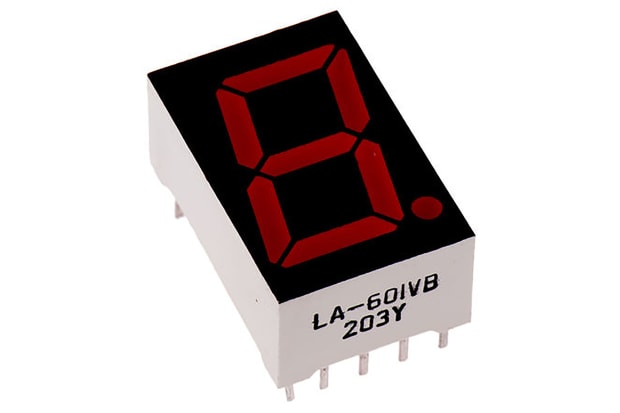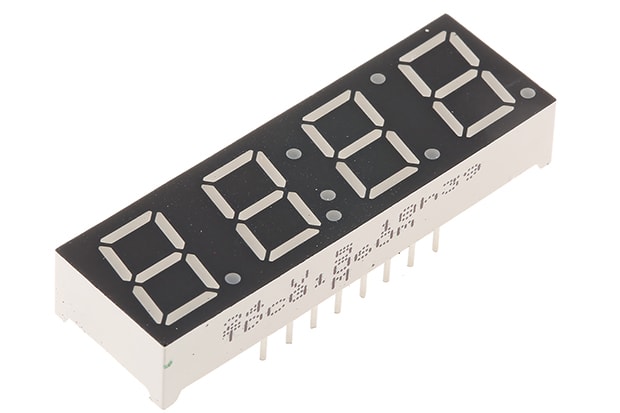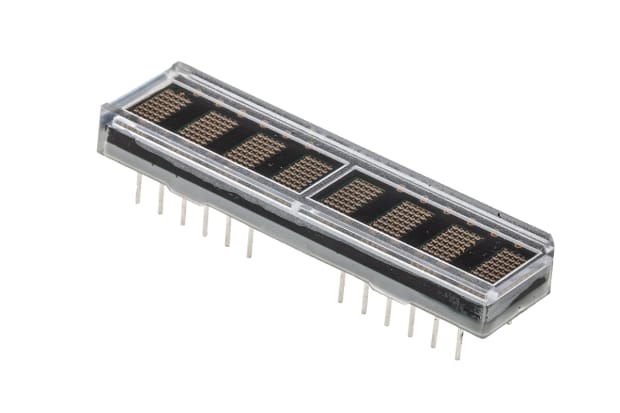- Published 28 Mar 2024
- Last Modified 28 Mar 2024
- 6 min
A Complete Guide to LED Displays
Our guide looks at what LED displays do and their uses, plus the different types and sizes that are available.

What is an LED Display?
An LED (Light-Emitting Diode) is a small cell or conductor that glows and becomes illuminated when a voltage is applied to it.
The phrase 'LED display' is often used broadly to describe screens on a wide range of devices. This includes commercial and consumer technology such as TVs, mobile phones, and PC monitors.
These high-resolution LED displays tend to use highly dense diode arrays - often numbering in the thousands - to control illumination and colour cycling across millions of individual pixels. This allows for the rendering of highly detailed moving images at pixel densities of up to 4k and beyond.
However, in engineering component terms, the definition of an LED display is more commonly taken to be a discrete light-up readout board. Often relatively small and simple, they are designed to be attached to an instrument panel or mounted on a printed circuit board (PCB). The purpose of these types of LED displays is typically just to provide clear and concise information readout for the user.
Such LED displays are often designed around the classic segmented number format. Other more advanced models may use a range of alternative display styles and diode configurations, including popular versions sold with either dot matrix or light bar arrays.
Types of LED Displays
There are numerous LED display panel types on offer. Some of the more common configurations include segmented displays, dot matrices, alphanumeric and light bar versions.
The sections below provide a closer look at the differences between these types of LED screens and outline when a particular model or style might prove more useful or economical.
Dot Matrix LED Display
LED dot matrix displays can be considered as the next logical step up from 16-segment alphanumeric arrangements. In a typical dot matrix LED display, the clustering of individual diodes is dense, while the dots (LEDs) are typically arranged in a rectangular grid that is wider than it is tall.
The basic operating principle of an LED matrix display is straightforward. By turning individual lights on or off in programmable sequences, full alphanumeric displays can be rendered as a matrix in reasonable detail. The precise level of detail achievable will depend on the density of the LED array and the resolution of the dot matrix. This may also impact the digit height.
Standard resolutions for many LED matrix displays include:
- 128x16 (two-lined)
- 128x32 (four-lined)
- 128x64 (eight-lined)
- 92x31 (four or three-lined)
An LED dot matrix display is commonly used with all manner of billboards, hoardings, signage, and video walls. They can leverage additional detail and clarity over segmented number LEDs to show more complex information. They are often found in city centres and commercial areas, particularly with outdoor 3D LED displays for advertising or information purposes, and are easily programmed to display:
- Simple images and symbols
- Prices
- Temperatures
- Times and dates
- Seamless scrolling news ticker updates and messages
7-Segment LED Display
An LED 7-segment display is one in which any numeral can be laid out using an arrangement of seven separate LED segments. The individual diodes in a 7-segment display are arranged in a rough figure-eight system so that each LED segment can be individually illuminated (or left unlit), allowing the grouping to display any digit from 0-9.
Seven-segment display arrangements are sometimes abbreviated to SSDs and can also be referred to as seven-segment indicators. They are among the most common LED display configurations used for providing simple numerical readouts on a broad range of device types.
Seven-segment displays are generally limited to showing numerals. They are not considered especially suitable for lettering, as the minimal number of segments in each LED display makes it difficult to render sufficiently readable characters.
14-Segment LED Display
A 14-segment LED display takes much the same basic format as the 7-segment version but uses double the number of diodes. They are arranged in the familiar figure-eight shape, but with the addition of diagonal diodes crossing through the centre point. This configuration is also known as a Union Jack or starburst LED display.
The increased LED count allows for a significantly more detailed display, meaning that full alphanumeric readouts become much more feasible. However, even with fourteen segment displays, some letters in the alphabet remain difficult to render with great clarity.
In the mid-1980s, pinball machines and other arcade games were among the first everyday devices to help popularise the LED 14-segment display. In some design applications, the format is still used to achieve a stylised retro aesthetic. 14-segment displays remain a popular option for many device types.
16-Segment LED Display
As with 7-segment and 14-segment displays, a 16-segment LED display also conforms to the same basic figure-eight module arrangement. However, an additional pair of diodes are added by splitting both the upper and lower horizontal segments into two.
This allows for yet more detail in the graphical rendering of numbers and letters. It is generally deemed sufficient for reasonably full alphanumeric LED display readouts on devices where a more intricate dot matrix LED display is impractical or unnecessary.
Common Uses
LED displays can be used for a wide range of applications across a variety of industries. They are commonly used in commercial and retail environments as well as domestic and consumer-grade equipment, making them highly versatile electronic components.
Some common indoor and outdoor uses of LED message displays include:
- Basic calculators
- Many types of digital clocks and timers
- Programmable LED displays for prices
- LED number display boards
- Electronic meters
- DVD players
- Car stereo fascias
- Microwaves and ovens
- Caller ID phone screens
- Speakers and car stereos
- Digital scales and shavers
- Arcade games and slot machines
- Public information LED text displays and scoreboards
- LED video walls and large-scale installations
It should be noted that not all display types will be suitable for each of the uses above. Factors such as the display type, colour, size, brightness, and the number of characters required will all help to determine which LED display sign is the best solution for your particular application.
Display Sizes
These displays are highly scalable and can be used for a wide range of screen and LED panel sizes. From large LED displays to very small LED displays, the quality and efficiency will remain the same. As a result, the best screen size will ultimately depend on your specific requirements. A big LED display will be beneficial for outdoor applications and public spaces, for example, whereas smaller models are ideal for personal devices.
LCD vs LED Displays
When considering an LED display vs LCD options, it is important to clarify the differences and similarities between the two types. The key fact to underline is that LED displays are LCD displays - they are just a specific subset of the broader LCD technology.
LCD stands for Liquid Crystal Display. The acronym can be used to describe any panel or display that uses liquid crystal to control where (and how much) light is displayed in each on-screen pixel at any given moment.
Many types of LED displays use this technology - and so they are LCD screens by definition. The fact that they also use LEDs to backlight these pixels is what defines LED displays as a subset.
It is also important to note that almost all modern LCD displays are LED variants. The previous common method of lighting LCD screens was using cold cathode fluorescent lamps (CCFLs), and some panel-makers do still include CCFL options, the vast majority of brands now use LED technology.
Designed to be eye-catching and to captivate those viewing them, these control systems are often designed for high brightness, low power consumption, high refresh rate, and a multicolour, large format functionality.
Summary
LED displays of all types are incredibly versatile tools for providing clear, crisp, energy-saving and environmentally conscious readouts of visual information across a wide range of applications, industries and projects.
They’re increasingly widely used both at home and in the workplace, and their ever-growing popularity means that the catalogue of available LED display products is continually growing. The sheer range of LED display panel prices, suppliers and models on the market today can seem intimidating at first, but it’s easily navigated with a basic knowledge of their various configurations and functions.


